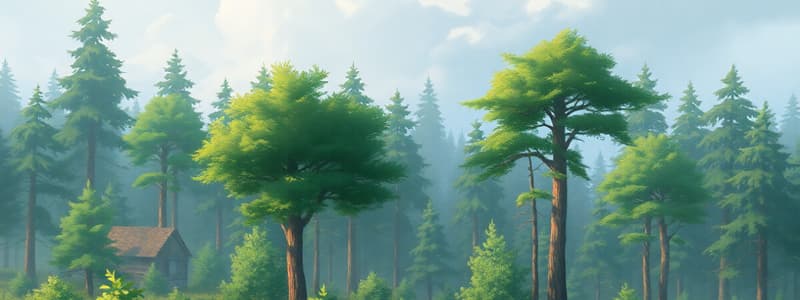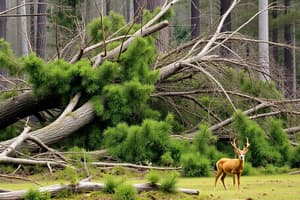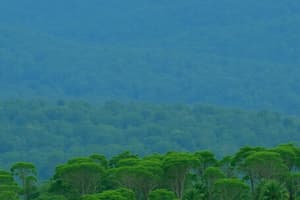Podcast
Questions and Answers
What characterizes a Class 5 wildlife tree?
What characterizes a Class 5 wildlife tree?
- It has branches missing and is at least 2/3 its original height.
- It is entirely rotted through, showing extensive decay.
- The tree is alive and supports large wildlife populations.
- Sapwood and heartwood are very soft, with most limbs gone. (correct)
Which indicator is NOT associated with danger trees?
Which indicator is NOT associated with danger trees?
- Dead, broken, forked, cracked tops.
- Healthy green leaves. (correct)
- Extensive rot.
- Broken or hanging branches.
What are common management options for danger trees?
What are common management options for danger trees?
- Establish a no work zone around the tree. (correct)
- Allow nature to take its course without intervention.
- Replant new trees to replace the danger tree.
- Remove all danger trees immediately.
What determines if a tree is classified as potentially hazardous?
What determines if a tree is classified as potentially hazardous?
Which class of tree has heartwood rotted through and extensive rot?
Which class of tree has heartwood rotted through and extensive rot?
What is the main purpose of wildlife tree management?
What is the main purpose of wildlife tree management?
Under which legislation is it an offence to damage land set aside for wildlife?
Under which legislation is it an offence to damage land set aside for wildlife?
Which of the following species relies on wildlife trees for feeding and shelter?
Which of the following species relies on wildlife trees for feeding and shelter?
What characteristic is NOT associated with wildlife trees?
What characteristic is NOT associated with wildlife trees?
What primarily influences the formation of wildlife trees?
What primarily influences the formation of wildlife trees?
Which of the following would typically be considered a wildlife tree habitat feature?
Which of the following would typically be considered a wildlife tree habitat feature?
What natural process might create a chimney in a wildlife tree?
What natural process might create a chimney in a wildlife tree?
Which attribute is a result of natural disturbances that can create natural cavities in wildlife trees?
Which attribute is a result of natural disturbances that can create natural cavities in wildlife trees?
What characteristic is NOT important for ranking wildlife trees?
What characteristic is NOT important for ranking wildlife trees?
Which class of wildlife trees has live, healthy trees without structural defects?
Which class of wildlife trees has live, healthy trees without structural defects?
What indicates a Class 4 wildlife tree?
What indicates a Class 4 wildlife tree?
What is a key feature that increases the value of wildlife trees?
What is a key feature that increases the value of wildlife trees?
Which condition is typical for a Class 3 wildlife tree?
Which condition is typical for a Class 3 wildlife tree?
What does a high wildlife tree classification primarily assess?
What does a high wildlife tree classification primarily assess?
Which factor does NOT influence the distribution and mortality of wildlife trees?
Which factor does NOT influence the distribution and mortality of wildlife trees?
Which of the following factors represents a pathological indicator of tree health?
Which of the following factors represents a pathological indicator of tree health?
What is the typical condition of a wildlife tree in Class 5?
What is the typical condition of a wildlife tree in Class 5?
Which feature does NOT determine the value of a wildlife tree?
Which feature does NOT determine the value of a wildlife tree?
What is an example of a primary cavity excavator?
What is an example of a primary cavity excavator?
Which of the following is primarily supported by wildlife trees?
Which of the following is primarily supported by wildlife trees?
What tree characteristic is most important for determining the value of a wildlife tree?
What tree characteristic is most important for determining the value of a wildlife tree?
Which of the following is an important use of wildlife trees by various species?
Which of the following is an important use of wildlife trees by various species?
What stage of decay is most advantageous for wildlife trees?
What stage of decay is most advantageous for wildlife trees?
Which tree species is considered highly valuable as a wildlife tree?
Which tree species is considered highly valuable as a wildlife tree?
What is a common characteristic of wildlife trees that enhances their ecological value?
What is a common characteristic of wildlife trees that enhances their ecological value?
What is the minimum height for a tree to be considered valuable as a wildlife tree?
What is the minimum height for a tree to be considered valuable as a wildlife tree?
Which of the following species is NOT typically associated with secondary cavity excavation?
Which of the following species is NOT typically associated with secondary cavity excavation?
Which characteristic describes a tree with a greater potential for supporting wildlife?
Which characteristic describes a tree with a greater potential for supporting wildlife?
Flashcards
What is a Wildlife Tree?
What is a Wildlife Tree?
Any standing dead or live tree, providing valuable habitat for wildlife conservation or enhancement through special characteristics.
What is a Wildlife Tree?
What is a Wildlife Tree?
A living tree with unique features, like cavities, loose bark, or dead branches, offering resources for animals.
Natural Cavities (Wildlife Tree)
Natural Cavities (Wildlife Tree)
Naturally formed holes or cavities in trees, often created by wind or ice damage.
Chimneys (Wildlife Tree)
Chimneys (Wildlife Tree)
Signup and view all the flashcards
Wildlife Tree Attributes
Wildlife Tree Attributes
Signup and view all the flashcards
Wildlife Tree Importance
Wildlife Tree Importance
Signup and view all the flashcards
Wildlife Tree Legislation (BC)
Wildlife Tree Legislation (BC)
Signup and view all the flashcards
Wildlife Tree Management
Wildlife Tree Management
Signup and view all the flashcards
Primary Cavity Excavation
Primary Cavity Excavation
Signup and view all the flashcards
Secondary Cavity Excavation
Secondary Cavity Excavation
Signup and view all the flashcards
Species in a Wildlife Ecosystem
Species in a Wildlife Ecosystem
Signup and view all the flashcards
Wildlife Tree Uses
Wildlife Tree Uses
Signup and view all the flashcards
Wildlife Tree Value
Wildlife Tree Value
Signup and view all the flashcards
Most Valuable Wildlife Tree Species
Most Valuable Wildlife Tree Species
Signup and view all the flashcards
Identifying Important Wildlife Tree Characteristics
Identifying Important Wildlife Tree Characteristics
Signup and view all the flashcards
Tree Classes for Wildlife Trees
Tree Classes for Wildlife Trees
Signup and view all the flashcards
What are Wildlife Trees?
What are Wildlife Trees?
Signup and view all the flashcards
What is a wildlife tree's diameter?
What is a wildlife tree's diameter?
Signup and view all the flashcards
What is a wildlife tree's decay stage?
What is a wildlife tree's decay stage?
Signup and view all the flashcards
What is a wildlife tree's height?
What is a wildlife tree's height?
Signup and view all the flashcards
What is a wildlife tree's location?
What is a wildlife tree's location?
Signup and view all the flashcards
What is a wildlife tree's structural strength?
What is a wildlife tree's structural strength?
Signup and view all the flashcards
What are Class 1 wildlife trees?
What are Class 1 wildlife trees?
Signup and view all the flashcards
What are Class 2 wildlife trees?
What are Class 2 wildlife trees?
Signup and view all the flashcards
What are Class 3 wildlife trees?
What are Class 3 wildlife trees?
Signup and view all the flashcards
What are Class 4 wildlife trees?
What are Class 4 wildlife trees?
Signup and view all the flashcards
What is a Danger Tree?
What is a Danger Tree?
Signup and view all the flashcards
WorkSafe BC & OHS guidelines
WorkSafe BC & OHS guidelines
Signup and view all the flashcards
Assessing Dangerous Characteristics
Assessing Dangerous Characteristics
Signup and view all the flashcards
Danger Tree Indicators
Danger Tree Indicators
Signup and view all the flashcards
Common Management Options
Common Management Options
Signup and view all the flashcards
Study Notes
Wildlife and Danger Tree Classification
- Wildlife trees are a crucial part of ecosystems, providing habitat for animals and contributing to biodiversity.
- Wildlife tree management began in BC in 1985.
- This management is complex due to its overlap with human safety concerns.
- The aim is to conserve wildlife trees and associated stand-level biodiversity efficiently in forests, parks, and urban environments.
- The Forest and Range Practices Act (FRPA) and the Wildlife Act prohibit damaging, altering, or destroying land set aside for wildlife.
- In BC, roughly 15% of birds, mammals, and amphibians depend on wildlife trees for food and shelter.
- Examples of animals relying on wildlife trees include woodpeckers, nuthatches, owls, wood ducks, martens, fishers, flying squirrels, and black bears.
- Snags, deciduous trees, and large veteran trees are vital wildlife tree habitat features.
What is a Wildlife Tree?
- Wildlife trees are standing, dead, or live trees with features providing valuable habitat for wildlife conservation and enhancement.
- Wildlife tree formation occurs through various life and decay stages, often influenced by biotic and abiotic factors such as insects, fire, fungi, and weather.
- Tree mortality factors include wound decays (saprophytes, heart rots, etc.), stem and bark diseases, bark beetles, defoliators, insects, diseases, and abiotic factors like wind, frost, lightning, snow, and fire.
Wildlife Tree Attributes
- Key characteristics of wildlife trees include natural cavities, chimneys, cavity excavation and feeding holes, heart rot, loose bark, forks and branching, dead/spike tops, snags, and witches' brooms.
- Natural cavities are created by natural disturbances like wind or ice. Chimneys are formed by fire or rot.
- Primary cavity excavation is done by birds like woodpeckers, nuthatches, and chickadees.
- Secondary cavity excavation is sometimes done by other animals using existing cavities.
- Other attributes include heart rot, loose bark, snags, dead/broken tops.
Ecological Values
- Wildlife trees support approximately 25% of all forest-dwelling terrestrial vertebrates in BC.
- They are crucial habitat for a wide variety of species, influencing local biodiversity.
Wildlife Tree Species Support Elements
- Wildlife trees support fungi, plants, invertebrates, birds, amphibians, reptiles, and mammals. They are an integral part of the ecosystem.
Wildlife Tree Uses
- Various species use wildlife trees for nesting, feeding, communication (drumming/marking), roosting, shelter, and overwintering.
Ranking Wildlife Trees
- The value of a wildlife tree depends on its characteristics and the user's needs. Most valuable trees typically have high free height, diameter, decay stage, location, and mortality.
- Native species are generally more valuable. Examples include Douglas-fir, Western Larch, Ponderosa pine, trembling aspen, cottonwood, cedars, hemlocks, and true firs.
- Important characteristics include height (greater than 15 m), diameter, decay stage, and location (topographical). Distribution and tree mortality factors are also important.
Danger Trees
- A danger tree is a tree present in areas where people are operating or recreating, exhibiting unstable characteristics and potentially posing a hazard.
- Assessing danger is done by qualified assessors.
- Dangerous characteristics can result from location/lean, physical damage, overhead condition, and deterioration of limbs, stem, or root systems. Specific indicators include dead, broken, cracked or forked tops, lightning scars, large dead limbs, broken branches, large cankers, split trunks, extensive rot, and damaged/exposed root systems.
Common Management Options
- Retaining trees is preferable if possible..
- Mitigating risk through no-work zones or removal of hazardous parts may be needed.
- Establishing wildlife tree reserves is a beneficial option for conservation.
Studying That Suits You
Use AI to generate personalized quizzes and flashcards to suit your learning preferences.




